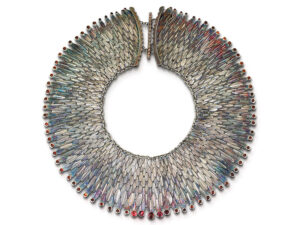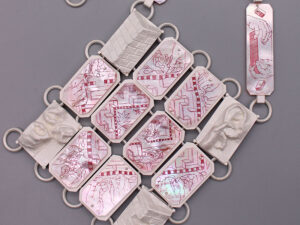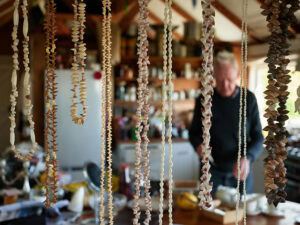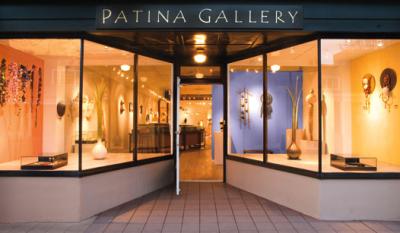
Susan Cummins: Ivan and Allison, you are partners in the gallery. Correct? Can you give me some idea about your backgrounds? How did you get into this business?
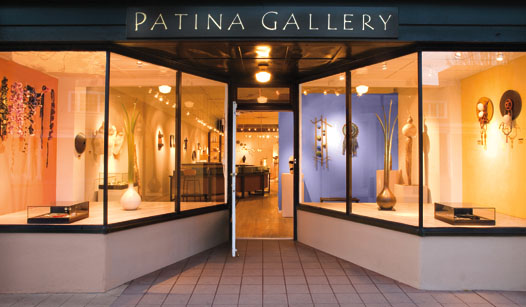
Susan Cummins: Ivan and Allison, you are partners in the gallery. Correct? Can you give me some idea about your backgrounds? How did you get into this business?
Allison Buchsbaum-Barnett: I have a BFA in metalsmithing from Syracuse where I studied with Michael Jerry and Barbara Walter. I also studied in Florence. I always knew I wanted to be an artist. I would spend weekends with my grandmother, Gigi and godmother, Ellie. Both painted and they would talk with me about what they did. My grandmother also had a clothing shop in New Orleans – the clothing shop there – and had impeccable taste. She traveled to Paris every year on buying trips to bring back the latest fashion for her clients. I admired her so much and learned a lot about style from her. She was like Hepburn and had amazing clothes. I remember she wore fluid slacks and a slouch shirt with the collar turned up, fabulous shoes . . . I wish she was here now to see Patina.
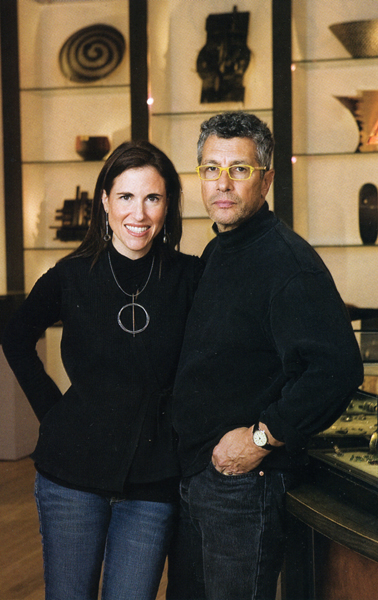
Ivan Barnett: I graduated in 1969 from Philadelphia College of Art, now the University of the Arts, with a degree in illustration. My father, Isa, was an important illustrator and so it was a genuine interest but I didn’t pursue it as a career. I always wanted to be independent and start my own business. I began doing craft shows in the early seventies in Bennington and then at Rhinebeck, first with candles and then mobiles and weather vanes. I moved to Santa Fe in 1992. I left behind my studio in Pennsylvania where I was doing mostly limited production works, which I’d done for more than 20 years. I began a new body of work in Santa Fe and was also doing some business consulting with other artists, using my 20 years experience in craft.
Allison and I were married in 1997 and soon after began talking about opening our own gallery, combining our different skills and shared passion for things made by hand. Allison is so amazing with people and I have a long history in the business of craft. We felt our combined talents and experience could be complementary. That’s how Patina began.
How long have you had the gallery? I understand you show a variety of craft based objects including jewelry and I wondered if you could describe your criteria for choosing work.
Allison Buchsbaum-Barnett: We opened the gallery in 1999 and from the beginning, our decisions about the work we show has come down to quality of craftsmanship and strong design. I have to love what I sell and so it’s always a question of, ‘Would I want this? Would I want to live with it?’ Patina is an extension of our personal taste so we have to love what we show.
Ivan Barnett: First and foremost, we always make an aesthetic decision. Of course we show of the greatest names in contemporary jewelry because their work is so exceptional but I think we are a little unusual. It’s always about the visual and how it’s made. It has to move us.
Allison Buchsbaum-Barnett: Myung Urso is a great example. When we first saw her work we were instantly aware of how fresh it is. She’s thinking outside the box. I love it because it’s so daring. We didn’t know her or even know of her, we just saw the work and wow, we loved it.

Allison Buchsbaum-Barnett: The word ‘patina’ is about something that changes and develops character with time, something that has a story and layers. This is the soul-stirring part because we are drawn to works that have depth and meaning.
Ivan Barnett: For me, ‘soul-stirring’ describes an experience. I can admire an object or piece of jewelry and that’s different from being moved by it. It’s the difference between a cerebral appreciation and a visceral one. Sometimes we use words in an equation form to describe this, Patina = Beauty Over Time.
Allison Buchsbaum-Barnett: And soul-stirring is almost as much about the Patina space as about the work we show within it. It comes out of combinations of material and scale, big and small, in the same space. We experience beauty deeply and want people to share that through the Patina experience.
Since you are makers as well as gallerists, is your studio connected to the gallery? How would you describe what you make?
Allison Buchsbaum-Barnett: Since we opened the gallery, our studios have been in our home. I’m not currently a maker but I have fun making jewelry with our daughter who is just eight years old. My creative expression, for now, is satisfied by my work here in the gallery. I curate the jewelry. Ivan curates the objects. Each case of jewelry that I stage is a composition. I’m always considering how the pieces relate to one another. Their placement matters deeply.
Ivan Barnett: I think of Patina as a work of art in and of itself, and it is constantly changing. It is a dynamic and organic work of art. Everything for me is design. I’m pretty driven, even a little obsessive about it. I’m drawn to making things that are collages or assemblages, in a range of materials and it’s always about great composition and surprise.
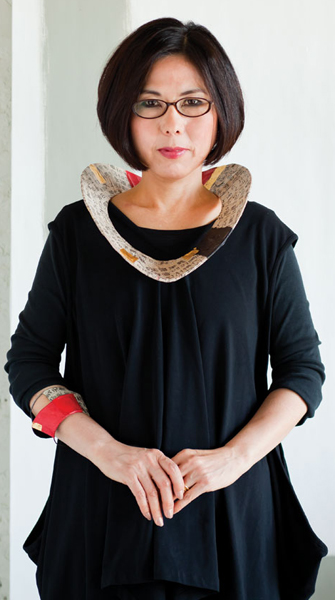
Ivan Barnett: Observations is a new program we’ve developed which allows people to observe jewelry artists as they create their work and talk about ideas and process. Linda’s done an amazing job. She’s a maker and educator and has taken up the project with total commitment. She set up a jeweler’s bench in Patina’s back room and is creating a very authentic experience of making. All the equipment is there. When jewelry artists arrive at Patina for an exhibition, we ask them to bring works in different phases of completion. Linda compares it to a cooking show. It’s our way of educating the viewer about the making process. To see something as it is being made elevates its meaning and allows a deeper understanding of the work. It’s part of ‘stirring the soul.’
Allison Buchsbaum-Barnett: We often describe process and technique to clients but words really can’t do it justice. Now they can see it done. At art schools they’re doing everything on computers. Observations brings it back to the hand. We only choose things for the gallery that are made by hand. This is a very deliberate commitment.
Santa Fe has a large art community and I am curious how you feel about having your gallery located there.
Allison Buchsbaum-Barnett: Santa Fe is our home. It’s the perfect location because there’s such a range of interests. People are exposed to so much great jewelry made by different cultures here. When people decide to come to Santa Fe, they are ready to experience art at all levels. They’re hoping for a new and unusual experience and that’s what we want to offer.
Ivan Barnett: We’re around the corner from the O’Keefe Museum, dedicated to one of the world’s most famous female artists. She came to New Mexico for the same reasons people travel to New Mexico today. People have been coming here for a hundred years for the culture, seeking something ‘soul-stirring,’ something . . . other. Santa Fe is the perfect location for Patina.
Thank you Ivan and Allison. Now I am going to ask Myung Urso about her exhibition Line + Brush, which is just opening at Patina. Can you tell us the story of how you became an art jeweler?
Myung Urso: ‘Where am I?’ When I reached the point of asking myself this question I was already in my mid- forties. I had previously pursued my passion of promoting Korean contemporary crafts. But this question to myself was a wake up call and it eventually led me to move to the United States and leave my past career behind me in South Korea. When I came to America in 2006 I realized that I was facing a totally unknown future. I sat alone and asked myself, ‘what do I have now and what can I do with it?’ My husband, Leonard Urso, a professor at the School for American Craft at RIT has always encouraged my creativity and he supported my decision to start making jewelry. Fortunately his jewelry studio was already set up in our house. He no longer needs it now since he works on a larger scale so he wasn’t using it. Jewelry has always been my favorite art form. Jewelry is a small medium though has wholesome artistic qualities. In the beginning I was scared of making things with my hands, since I had not worked with my hands for many years. Soon after, I found myself having fun playing with materials and it also became a form of meditation in my daily life.
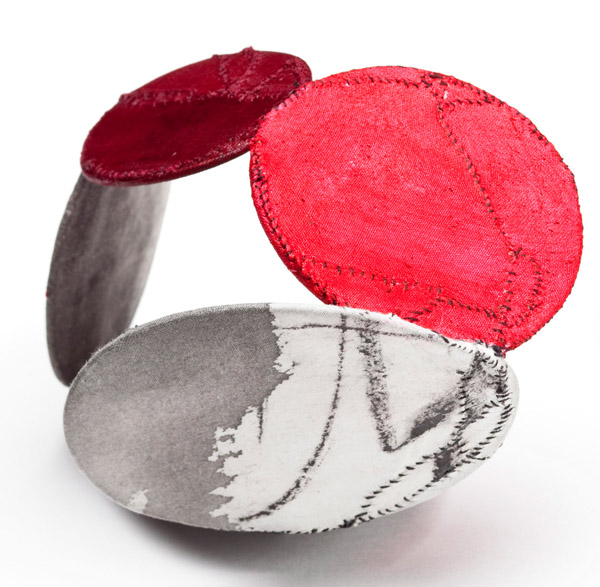
Myung Urso: My educational background includes a BA in Biology from Hannam University with a middle/high-school teaching certificate, an MFA in Fiber Art from Hongik University in Korea and an MA in Museum & Gallery Management from City University in England. As far as I can tell these many subjects are related to each other. I am mostly self-trained in jewelry making, though I have had a few courses for basic techniques at a local institution. Actually I think working with my mother developed my hand skills. I assisted her while she supported her six children. Having a big family in the traditional Korean family culture requires being efficient in craft practices. Korean education systems from primary school on also led me to practice many sorts of art forms, which include calligraphy, sewing, crafts and art in general.
Can you describe in more detail how you transitioned from fiber art to using fiber in jewelry? And why?
Myung Urso: It was a personal preference to be fascinated by tactile materials in many kinds of fiber forms. I remember as a school student I used to wander around markets for hours and hours looking for interesting textures. This interest became the focus for my MFA thesis, which was an exploration between fiber and metal compositions. It is also why I am pursuing it in my current work. Fiber is most the most familiar material to me. If I have to make something with my hands then there is no option, there should be fiber in it.
You are unique in the way you use fiber, wire, stitching and ink. My impression is that these things produce work that has a traditional Asian look. Do these pieces relate to some historical objects or jewelry?
Myung Urso: Interestingly, an American antique Swan decoy from our antique collection inspired the idea of using fabric over silver wire forms. The Swan is made from a white cotton fabric, which is stretched over a wooden and metal wire structure. I am sure my jewelry pieces are influenced by my native Asian culture though not directly. Korea has such a rich paper and fiber tradition, but my jewelry came from my ability to put different ideas together. To be honest, I never expected I was going to do so much hand sewing. I suppose that you could say the skill is hereditary in some ways, which could be another historic aspect.
Can you name some artists who have influenced you?
Myung Urso: I am not able to display all the artists’ names that I am influenced by because there are too many names throughout my life and previous career. Surprisingly I have often been told that my work reminds people of Alexander Calder. I understand where this comes from and l like the comment.

Myung Urso: Promoting Korean contemporary craft was my early career goal and dream. This goal mostly focused on persuading the general public to become aware of Korean contemporary craft. One of my accomplishments was presenting Korean Crafts Now to an audience that included the late President Dae-jung Kim at Cultural & Tourism Ministry in 2000. I also invited several American Jewelry artists such as Biba Shutz, Ford & Forlano and Terry Logan to the Art-full Jewelry exhibition in 2005. I also worked to exhibit Korean artists’ works to other countries in exhibitions such as Meditation in Metal: Korean Art Jewelry and Hollowware at Mobilia Gallery, Boston, in 2001 and I organized a Korean Furniture show at Salon de Meuble de Paris 2006 for the Korean Craft Promotion Center.
What are some recent jewelry books you have found interesting?
Myung Urso: Hans Silvester, Natural Fashion: Tribal Decoration from Africa and Lisa Walker, Unwearable Appendix.
Can you pick three pieces that are in the Patina show and explain their meanings?
Myung Urso: Necklace Floating – I have been working with repeating flat oval shapes and find it is quite interesting to play with the variation of the same form while l create different structures. For the Patina exhibition I approached the concept of creating more three-dimensional jewelry forms.
Brooch Symbol – Recently I was inspired to create jewelry with theme of ‘sign of life’ given by a gallery. The Symbol brooch was developed into this new form, which looks like a silk warm (or fetus) and a cocoon (womb). Yellow is a color that for me symbolizes life, light and joy.
Neckpiece Red & Red – Full and empty, positive and negative, yin and yang make up the world and life.


